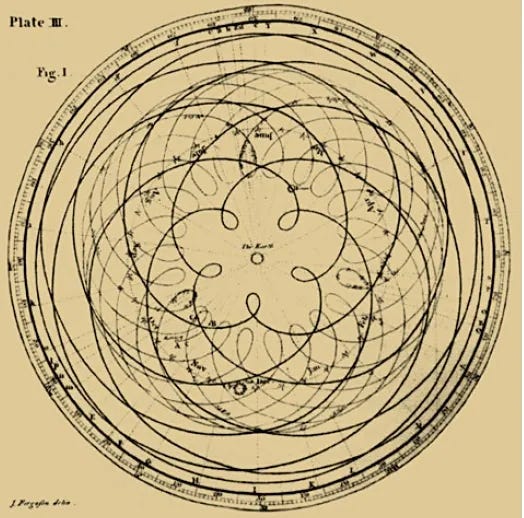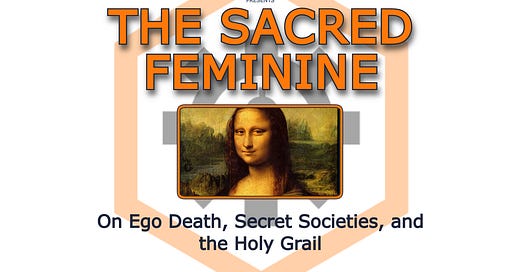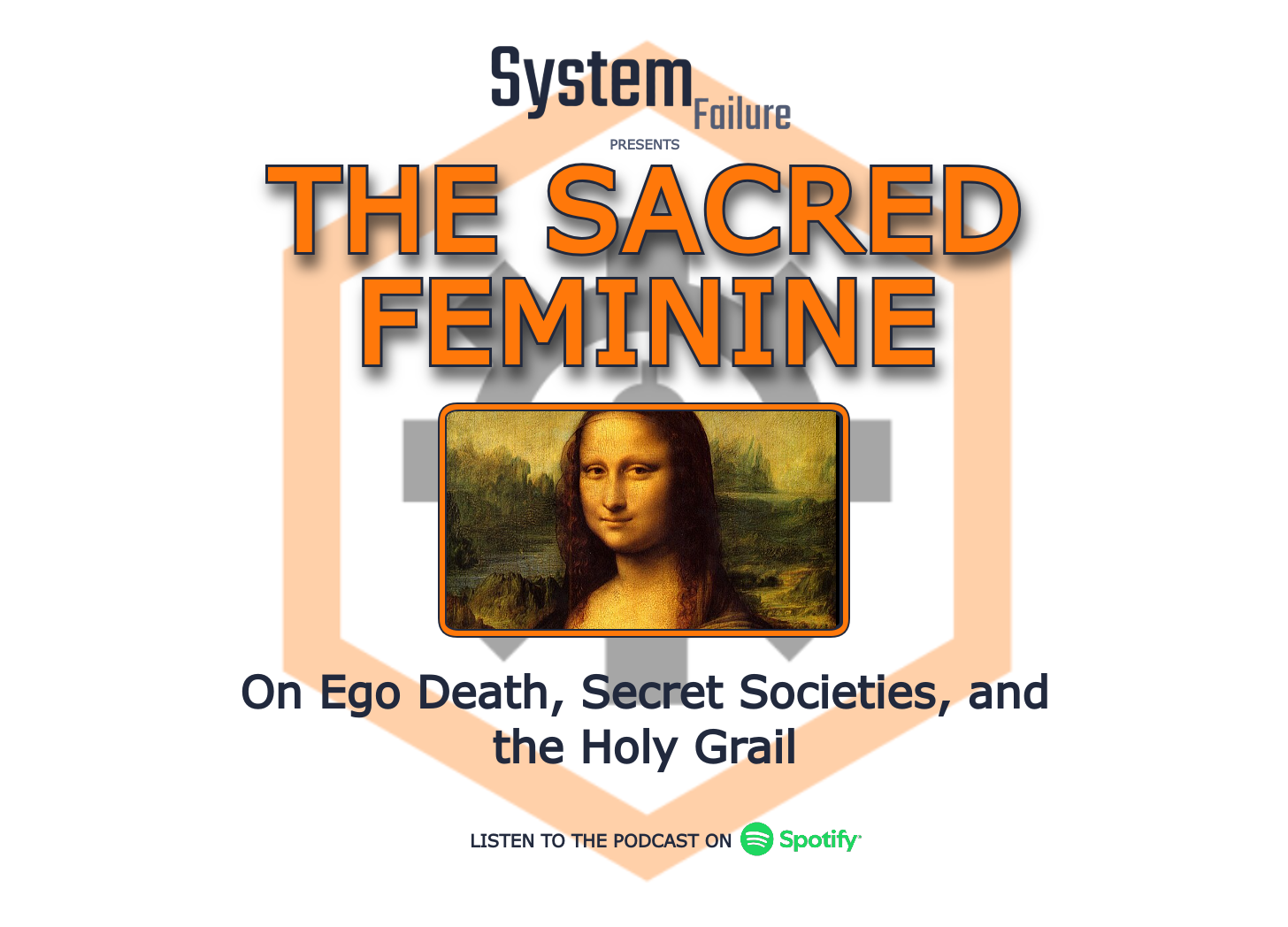Overview
With this essay, we continue the conclusion of Volume II of the System Failure constellation of ideas. Follow our progress on the Idea Map and Essay Schedule. It continues the theme of secret societies by taking a look at The Da Vinci Code. Its author hit upon the fact that the Grail is a symbol for the feminine. But he missed that femininity is itself a symbol for ego-death, an experience that the authorities generally don’t want people having. Opposition by political authorities is a big reason why secret societies exist, and why they use symbols like the Grail that are recognizable only to the initiated.
Introduction
Dan Brown’s electrifying 2003 thriller The Da Vinci Code became a major cultural touchstone by using the notion of secret societies to fuel an action-packed drama. Brown packed a lot of real history into his pages. But his conception of the Holy Grail is missing an important piece of the puzzle surrounding that holy relic: drugs and ego-death. These figure heavily into the true history of secret societies and the symbolism they use.
The Holy Grail
The Da Vinci Code culminates in a final scene at Rosslyn Chapel near Edinburgh, Scotland. In the novel, the Grail is neither a cup nor a chalice. It turns out to be a formerly living, breathing person.
That person was the biblical figure of Mary Magdalene. In The Da Vinci Code, Mary was not the reformed prostitute of her unfortunate reputation. She was instead Jesus’ wife. Pregnant at the time of the Crucifixion, Mary fled Palestine carrying a baby who was destined to establish a royal bloodline of French monarchs. According to the story, she herself is the vessel that contained the blood of Christ. Not some cup.
Dan Brown suggests that Mary’s special relationship with Jesus threatened his male apostles. In his story, they seized control over the early Christian Church by harshly demonizing femininity and, conveniently, their chief rival for the leadership of the early Church.
Those who remained loyal to Mary used the analogy of a mystical cup to refer to her without tipping off the new Church authorities. Centuries later, that demonization culminated in the fires of the witch trials and in the dungeons of the Inquisition. Or at least, so goes the story of The Da Vinci Code.
Brown’s tale of intrigue aroused the curiosity and imagination of millions. But he merely splashed around in the shallows, and never waded out beyond the breakers into the deep waters of the real truth…
Sex, Drugs, & Rock n’ Roll
Political authorities really do have a long history of demonizing the feminine. Dan Brown got that right. Those who venerated femininity often did so at their peril. To protect themselves from the authorities, they sometimes formed secret societies. These societies were called “mystery religions” because only those who had been properly initiated were permitted to know what went on behind closed doors.
In 186 BC, the Roman Senate violently suppressed the upstart Dionysian mystery religion. It was a cult for women, and their ringleader was a witch named Paculla Annia. 6,000 cultists were put to death in the political purge.
In 392 AD, the Christian Emperor Theodosius outlawed all non-Christian religious practices. He ordered a crackdown on the famed mystery religion that had been observed at Eleusis for 2,000 years. The Eleusinian mysteries were themed around the story of the grain goddess Demeter, her kidnapped daughter Persephone, and the magical old woman Hecate, who led the mother into hell to rescue her lost child.
Eleusis was run by women. Its secret was ergot, the psychedelic fungus that grows on “cereal” grains (Ceres is the Roman name for Demeter). That fungus is the very same used to first synthesize LSD in the 1930s, and was also responsible for the Salem Witch Trials. And it’s highly toxic. Knowledge of how to brew up a potion that would induce beatific visions without also killing the drinker was passed down through generations of priestesses.
In addition to being feminine in character, both the Eleusinian and the Dionysian mystery religions involved drugs. The psychedelic, barley-based potion served up at Eleusis was called the Kykeon. Meanwhile, the wine of Dionysus was mixed with enough psychoactive substances to fill an entire volume of Dioscorides’ classic pharmacopoeia.
The raging popularity of these mystery religions makes a lot of sense when one realizes that they were oriented around girls and drugs. And of course, they also featured a healthy disregard for authority that’s so central to the modern rock n’ roll ethos.
The Sacred Feminine
The age-old pagan tradition of venerating the feminine goes by the general term “The Sacred Feminine”. As the hippy-dippy religion of Jesus was co-opted by powerful muckety-mucks in Rome, they changed its character dramatically and declared war on the Sacred Feminine.
Dan Brown touches on this in The Da Vinci Code. He points out that the Pentagram—or 5-pointed star—is an ancient symbol of femininity because of the path traced across the night sky by the planet Venus. It forms a pattern that looks like a 5-pointed star or a 5-petaled rose. The cyclical nature of Venus’s appearances in the sky (shifting between the morning and evening star) mirrors cycles of renewal and fertility. Before it was thought to be the Greek Aphrodite or the Roman Venus, that planet was associated with the Sumerian goddess Inanna, her Babylonian counterpart Ishtar, and the Egyptian Isis.
The Pentagram, of course, is now associated with devil worship and witchcraft. When Christianity became the state religion of the Roman Empire, political leaders of Rome became the new Church fathers. But this didn’t make them any more kindly disposed toward sex, drugs, or rock n’ roll than they were in 186 BC when they brought down the hammer on the Dionysian mystery religion.
That’s why they dismantled the Feminine Trinity of Eleusis. Trinities are common fixtures in religions across the world, and Christianity kept the masculine conception of the Trinity alive and well to this day. It also kept two-thirds of the Feminine Trinity: the mother figure Demeter and the virgin Persephone are confusingly combined into the single figure of Mary (the mother of Jesus, not Mary Magdalene). Motherhood and virginity are, of course, notoriously incompatible.
It was the wise old woman, Hecate, who knows the medicinal properties of every plant, that had to go. Her archetypal figure was removed from the Feminine Trinity and recast as the evil witch. These terrifying consorts of Satan brewed magical potions and drew pentagrams to invoke black magic. This demonization of the feminine was well-captured in Dan Brown’s adventure tale.

The Illusion of Ego
Not only did two-thirds of the old feminine Trinity survive into the present as Mary (mother of Jesus) but so, too, did the drugs that were integral to the Greco-Roman mystery religions. The wine of Dionysus and the grain of Demeter live on as the wine and bread of the holy Eucharist.
The psychoactive ingredients once central to religious observance were phased out of Christianity to make that faith more palatable to power. These ingredients were crucial in the old mystery religions because they induce the experience of ego death. When historians Will and Ariel Durant wrote their 1939 book The Life of Greece, they had no idea psychedelic drugs were involved. Nevertheless, the Durants noted that pilgrims to Eleusis were “lifted up out of the delusion of individuality”. But that experience is the last thing the powerful want us having.
The authorities desperately want us to conceive of ourselves as locked inside our bodies, because our bodies are the only part of us they can get their hands on. You can lock a body in prison. Or inflict pain and suffering on it. But the moment someone stops identifying with their body, they are beyond political control.
That’s what the Crucifixion was all about; it was a very public demonstration of the limits of state power. The political authorities in that story were utterly powerless to control someone who’s realized they’re not their body and are therefore prepared to sacrifice it. The gruesome execution of Jesus only served to amplify his radical message, so that even the mighty Emperors of Rome were eventually forced to bend the knee and accept baptism into the Church of Christ.
Throughout history, the stunning realization that ego is merely an illusion has always been characterized as feminine. That’s because—during childbirth—women experience a forking of their individual person into two or more persons. The ability to bear children is symbolic of the realization that our egos are merely costumes we wear. Psychoactive plants allow us to temporarily discard these costumes and briefly explore a broader existence beyond the cramped confines of self-identity.
Political authorities would like the rest of us to wake up each morning and report to work, where we make them money. They don’t want us achieving transcendence and escaping from their mechanisms of control. That’s why the authorities are forever cracking down on psychoactive plants and promoting alternative substances like alcohol and sugar that—while they may be catastrophic to public health—present no threat to political power. And that’s why those who discover these substances tend to form secret societies and use symbols like the Holy Grail to refer to their discovery in ways that won’t arouse the suspicion of the authorities.
Conclusion
There are three layers to the symbol of the Holy Grail. Magical cups containing magical potions were very much a part of the pre-Christian religious landscape. So were secret societies, where the worship of the sacred feminine continued underground after Christian authorities took power in Rome. Dan Brown used this history to great effect in The Da Vinci Code. But the Sacred Feminine is itself symbolic…of the illusory nature of our own self-conception.
Further Materials
Around 20 BC the conservative historian Livy wrote his dramatic retelling of the scandal, portraying it “as a reaction against the sudden infiltration of too many Greek elements into Roman worship.” The final straw for the Roman senate was the Italian witch, Paculla Annia, the scandalous high priestess of Bacchus in Campania—the heartland of Magna Graecia, home to Naples and Pompeii. In the years leading up to the mass crackdown on the Dionysian Mysteries in 186 BC, Paculla Annia refused to initiate any men over the age of twenty. “Rather than having women in the control of men,” says Dr. Fiachra Mac Góráin, a classicist at University College London, “this cult is putting young, impressionable men under the control of women.” In a staunchly patriarchal society like Rome, that was an act of war. So the authorities made the flood of magical wine slow to a trickle.
Brian Muraresku, The Immortality Key, 2020, Page 217
One of the most beautiful of Greek myths, skillfully narrated in the Hymn to Demeter once attributed to Homer, tells how Demeter’s daughter Persephone, while gathering flowers, was kidnaped by Pluto, god of the underworld, and snatched down to Hades. The sorrowing mother searched for her everywhere, found her, and persuaded Pluto to let Persephone live on the earth nine months in every year—a pretty symbol for the annual death and rebirth of the soil. Because the people of Eleusis befriended the disguised Demeter as she “sat by the way, grieved in her inmost heart,” she taught them and Attica the secret of agriculture, and sent Triptolemus, son of Eleusis’ king, to spread the art among mankind. Essentially it was the same myth as that of Isis and Osiris in Egypt, Tammuz and Ishtar in Babylonia, Astarte and Adonis in Syria, Cybele and Attis in Phrygia. The cult of motherhood survived through classical times to take new life in the worship of Mary the Mother of God.
In the Greek sense a mystery was a secret ceremony in which sacred symbols were revealed, symbolic rites were performed, and only initiates were the worshipers. Usually the rites represented or commemorated, in semidramatic form, the suffering, death, and resurrection of a god, pointed back to old vegetation themes and magic, and promised the initiate a personal immortality.
Many places in Greece celebrated such mystic rites, but no other place in this respect could rival Eleusis. The mysteries there were of pre-Achaean origin, and appear to have been originally an autumn festival of plowing and sowing. A myth explained how Demeter, rewarding the people of Attica for their kindness to her in her wanderings, established at Eleusis her greatest temple, which was destroyed and rebuilt many times during the history of Greece. Under Solon, Peisistratus, and Pericles the festival of Demeter at Eleusis was adopted by Athens, and raised to higher elaboration and pomp. In the Lesser Mysteries, held near Athens in the spring, candidates for initiation underwent a preliminary purification by self-immersion in the waters of the Ilissus. In September the candidates and others walked in grave but happy pilgrimage for fourteen miles along the Sacred Way to Eleusis, bearing at their head the image of the chthonian deity Iacchus. The procession arrived at Eleusis under torchlight, and solemnly placed the image in the temple; after which the day was ended with sacred dances and songs. The Greater Mysteries lasted four days more. Those who had been purified with bathing and fasting were now admitted to the lesser rites; those who had received such rites a year before were taken into the Hall of Initiation, where the secret ceremony was performed. The mystai, or initiates, broke their fast by participating in a holy communion in memory of Demeter, drinking a holy mixture of meal and water, and eating sacred cakes. What mystic ritual was then performed we do not know; the secret was well kept throughout antiquity, under penalty of death; even the pious Aeschylus narrowly escaped condemnation for certain lines that might have given the secret away. The ceremony was in any case a symbolic play, and had a part in generating the Dionysian drama. Very probably the theme was the rape of Persephone by Pluto, the sorrowful wandering of Demeter, the return of the Maiden to earth, and the revelation of agriculture to Attica. The summary of the ceremony was the mystic marriage of a priest representing Zeus with a priestess impersonating Demeter. These symbolic nuptials bore fruit with magic speed, for it was soon followed, we are told, by a solemn announcement that “Our Lady has borne a holy boy”; and a reaped ear of corn was exhibited as symbolizing the fruit of Demeter’s labor—the bounty of the fields. The worshipers were then led by dim torchlight into dark subterranean caverns symbolizing Hades, and, again, to an upper chamber brilliant with light, representing, it appears, the abode of the blessed; and they were now shown, in solemn exaltation, the holy objects, relics, or icons that till that moment had been concealed. In this ecstasy of revelation, we are assured, they felt the unity of God, and the oneness of God and the soul; they were lifted up out of the delusion of individuality, and knew the peace of absorption into deity. In the age of Peisistratus the mysteries of Dionysus entered into the Eleusinian liturgy by a religious infection: the god Iacchus was identified with Dionysus as the son of Persephone, and the legend of Dionysus Zagreus was superimposed upon the myth of Demeter. But through all forms the basic idea of the mysteries remained the same: as the seed is born again, so may the dead have renewed life; and not merely the dreary, shadowy existence of Hades, but a life of happiness and peace. When almost everything else in Greek religion had passed away, this consoling hope, reunited in Alexandria with that Egyptian belief in immortality from which the Greek had been derived, gave to Christianity the weapon with which to conquer the Western world.
Will & Ariel Durant, The Life of Greece, 1939, Page 308





